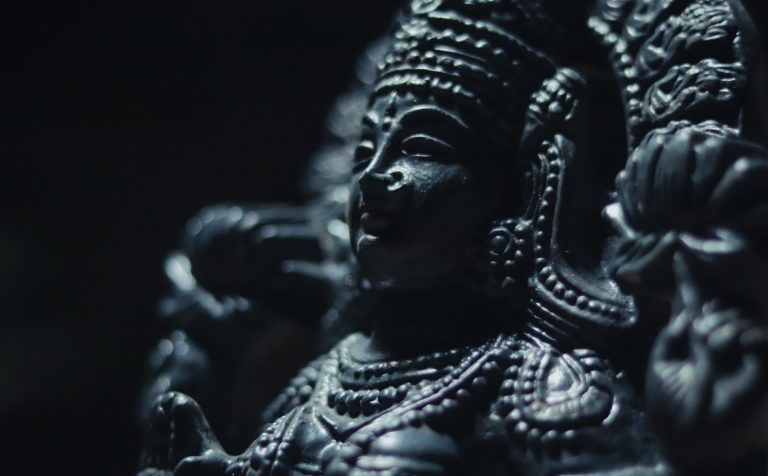The embodiment of intellect and the Destroyer of Obstacles, Lord Ganesha is widely revered as the Supreme Intelligence of the Universe. Mesmerizing devotees far and wide, Lord Ganesha continues to sow the seeds of inspiration in the hearts of the people – a testament to his evergreen character and persona.
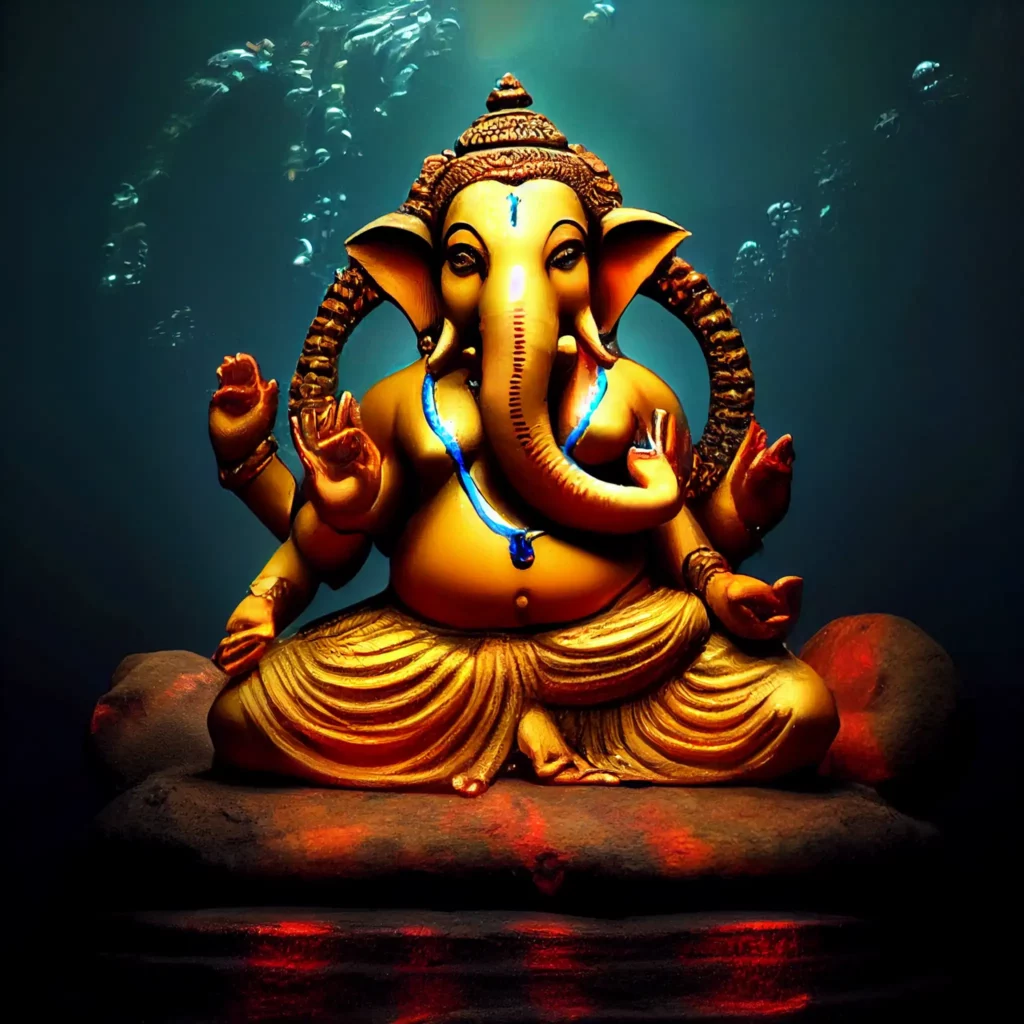
© Vedgyaan.com
Who is Lord Ganesha?
Ganesha (also known as Ganesa or Ganapati), Elephant-Headed, the harbinger of good fortune and prosperity, God of all Beginnings, is one of the most important and well-known deities in Hindu Mythology.
Ganesha is the son of Lord Shiva and his consort Parvati, Traditionally every Hindu puja or prayer begins with an invocation of Lord Ganesha in the form of the Ganesh Aarti of Ganesh Mantra. He is also widely revered as the Lord of Knowledge and wisdom, and is fondly referred to as the ‘Destroyer of Obstacles’. Before setting off on a difficult task or adventure, devotees call upon Ganesha to remove any obstacles from their path and to bless them with wisdom.
Ganesha is a dominant god in Hinduism but is also worshipped in Buddhism and Jainism.
Hindus are particularly very fond of Ganesha and celebrate a ten-day-long festival celebrating Ganesha and his teachings called Ganesh Chaturthi. It is a celebration of Lord Ganesha’s birth cycle, paying homage to his origin.
Epithets: Popular Names of Lord Ganesha
Lord Ganesha is fondly known by a variety of titles and epithets, out of which his most powerful names are – Ganapati, Lambodara, Ekdant, Vinayaka and Vighnaharta. Each name signifies a different meaning and often tells a story.
- Ganapati
Ganapati, for example, is derived from the words ‘Gana’ and ‘Pati’, which directly translates to ‘Lord of the People’ – A title bestowed upon him by Shiva after his revival.
- Vinayaka
Vinayaka means Lord of wisdom or intellect. When Ganesha defeated his brother in the race for the ‘Fruit of Knowledge’, Parvati bestowed the name Vinayaka on her son.
- Vighnaharta
Ganesha is widely referred to as ‘The destroyer of obstacles’ and before any daunting task, devotees invoke his name to rid them of any obstacles along their path. Hence, he is also fondly called ‘Vighnaharta’, which translates to ‘Remover of Obstacles.
- Lambodara
Ganesha is also fondly referred to as ‘Lambodara’. Lambodara is derived from the Sanskrit words Lamba and Dara, which means ‘Long Stomach’ or ‘Big Belly’. Ganesha is always depicted to have a potbelly, as he is said to contain the entire universe within his belly.‘Brahmandas’ or ‘Cosmic Eggs’ representing the past, present, future, and the source of all creation are said to reside inside Ganesha’s belly, making it appear large. It is also depicted as a big belly as it symbolizes Ganesha’s need to ingest ‘food for thought’, and his constant urge to assimilate and gather knowledge.
- Ekdant
The name ‘Ekdant’ comes from a story of Ganesha’s dedication to complete a task and stay true to his word. ‘Ekdant’ translates to ‘Single Tooth’, or in this case, ‘Single Tusk’. This is because Ganesha is always depicted with a broken tusk. It is also said that while attaching the head of the elephant to Ganesha’s body, Shiva accidentally chopped off one tusk.
Origin of Lord Ganesha
Lord Ganesha’s origin story is one of the most unconventional stories in the Hindu pantheon, and it all began with his parents Lord Shiva and Parvati, and was set into motion by Parvati’s loneliness caused by Shiva’s absence. Shiva was known for taking long meditation trips to the mountains, and would often go years without anyone seeing him. His wife Parvati however, never accompanied him during these trips, and would often be alone at home.
During one such trip, Parvati was overcome with loneliness and dejection and was unable to bear the stinging silence of her home any longer. Desperate for company, Parvati decided to create someone to give her company – A son of sorts.

(Public Domain)
Using the turmeric that she had gathered off of her skin, Parvati created the idol of a young boy. Her longing for someone loyal to her and to give her company allowed her to breathe life into her creation, resulting in the earliest version of Ganesha – The culmination of Parvati’s deepest desires.
Why does Ganesha have the head of an Elephant?
On one particular day, Parvati asked her son Ganesha to guard the door while she bathed and the condition was clear – Move aside for no one. Undoubtedly loyal, Ganesha immediately assumed his role at his mother’s door, not allowing a soul to enter while she bathed.
Unbeknownst to Parvati, this endeavor of hers, however, was soon to invite the wrath of Shiva. Surprisingly, this was the day Shiva had decided to return from his year-long meditation retreat.
On arrival at his doorstep, he was stopped by Ganesha – who was unaware of Shiva’s identity – and not allowed to enter his own home. Shiva was shocked and appalled to see an unknown, young, and handsome face at his door. Not being allowed to enter his home by this stranger sparked Shiva’s anger, causing him to begin plotting against this boy. After all, nobody would dare to block Shiva’s way, yet this boy unwaveringly stood against him in defiance.
Insulted by his insolence, Shiva sent armies after Ganesh, in hopes of defeating him. Much to his surprise, Ganesha defeated everyone who was sent his way with ease. With the creation of a powerful ‘Devi’, Ganesha was blessed with celestial power, which meant Shiva had to take matters into his own hands.
Blinded by his divine fury, Shiva severed Ganesha’s head and killed him, much to Parvati’s dismay.
Enraged and heartbroken by Ganesha’s Death, Parvati approached Brahma, intending to destroy all creation. Concerned by her erratic behavior, Brahma appealed to Shiva to find a solution and to calm Parvatidown.
Shiva who had now regained his rationale was determined to find a way to bring Ganesha back to life. And so, Shiva sent Lord Brahma off to find a replacement for Ganesha’s decapitated head-telling him to bring back the head of the first animal he sees.
As Lord Brahma made his way through the forest, he encountered a seemingly powerful elephant and decided that the head of this animal would be the replacement for Ganesha’s head.
Shiva would then seamlessly attach the elephant’s head to Ganesha’s body – bringing him back to life in the form that is widely adored today.
To further please Parvati and to make up for his mistake, Shiva crowned Ganesha as Lord of his ‘Ganas’ or his tribe – and thus, Ganapati was born. Shiva now proudly considered Ganapati to be his son and declared him the first and foremost deity – with wisdom far beyond the age of man and the ability to destroy any and every obstacle from the path of man.
Iconography: What does Lord Ganesha look like?
Ganesha has always been considered a mesmerizing figure in Hindu mythology. He is usually depicted as a chubby young boy, with a big belly and the head of an Elephant. He is also shown to have four arms, a broken tusk, and an axe, which is considered to be his weapon of choice. Even the name Ganesha represents the energy of the universe, from which all was created and all will be destroyed.
There is a deep symbolism behind Ganesha’s physical features – including his belly, trunk, wide mouth, and big ears.
Ganesha is always depicted with a big belly, as it is supposed to symbolize the entire universe. It also symbolizes the acceptance of all and generosity.
His head is widely revered as a symbol of rebirth and regeneration, wisdom and understanding. Gyan Shakti and Karma Shakti are also two terms that are often mentioned when describing Ganesha’s head – the power of wisdom and goodwill.
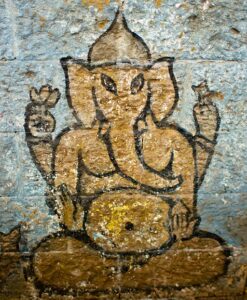
(Public Domain)
Furthermore, Ganesha is said to have large ears as it enables him to listen to the prayers and requests of all his devotees. His wide mouth is said to be a symbol of the inherently human desire to live life to its fullest and his trunk is a sign of strength and efficiency as it can hold onto anything in the universe.
In almost every depiction of Ganesha, he is shown with a broken tusk.
Legend has it that Ganesha wrote The Mahabharata, which was dictated to him by Vyasa. It is said that Vyasa and Ganesha had come to an agreement that stated that both parties would continuously dictate and write the Mahabharata without pausing. During this, Ganesha’s feather with which he had been writing broke, and to honor his agreement, he broke off his tusk and continued to write with it.
Ganesha has four arms, each symbolizing a different quality of self – including Mind, Intellect, Ego, and Conscience. One hand holds a lotus, which symbolizes enlightenment, while the other holds an Axe, which is said to be a tool that can be used to destroy ignorance in the universe. In another hand, he often holds sweet delicacies, which symbolize the rewards of being wise and his third hand is turned towards his devotees to shower his blessings upon them.
Why does Ganesha have a mouse as his vehicle?
There are a variety of myths and legends behind Lord Ganesha’s vehicle, the most popular story being that of the Musician-God Krauncha.
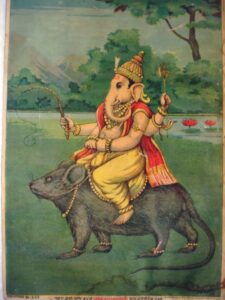
(Public Domain)
The legend says that one-day Krauncha was performing in the court of Indra, surrounded by courtiers and ‘Munis’ or ancient sages. Mid-performance however, Krauncha stepped on Muni Vamadeva’s foot accidentally. Enraged by this incident, the Muni cursed Krauncha to be a mouse, causing him to grow dramatically into a giant mouse. Krauncha was such a large creature, he destroyed everything in his path, one day destroying the ashram of a friend that was near and dear to Lord Ganesha. Intending to teach him a lesson, Ganesha set his noose around Krauncha’s neck, forcing him to his feet. Terrified, Krauncha begged Ganesha for forgiveness and due to his kind and understanding nature, Ganesha decided to forgive Krauncha and use him as his vehicle.
Another common belief is that Ganesha needed to travel to all the tiny crevices and hidden spaces in the Universe, and a mouse satisfied this requirement due to its ability to traverse narrow paths and dark nooks and crannies. The use of a mouse as his vehicle, therefore, symbolized the all-pervasiveness and omnipresence of Lord Ganesha.
Also known as the ‘Destroyer of Obstacles’, Ganesha was said to remove all obstacles in the lives of those who used to invoke his name. During Ganesha’s time, agricultural land was wrought with pests and rodents that used to damage useful crops, being a large problem for the farmers and people of the land. Ganesha’s vehicle is a mouse and is considered a symbol of hope as it portrayed a rodent-like creature such as a mouse being conquered and made subservient.
Wives of Ganesha
Ganesha always wished to get married, to a woman who possessed the same divine qualities as his mother, Parvathi.
According to the Ganesha Purana and the Mudgala Purana, Lord Ganesha had trouble finding a bride – especially with the qualities of his mother. He began to grow conscious of his body and believed that no one wanted to marry him for this reason.
Legend has it, He became very upset and angry. Every time he witnessed a wedding of other gods, he would cause chaos, putting the Gods in a dilemma. As a solution, Lord Brahma sent Riddhi and Siddhi, his Manas children (children born from his mind) to distract Ganesha whenever there was a marriage taking place.
In northern India, the two female figures are said to be Riddhi and Siddhi while Buddhi and Siddhi in Southern India.
Riddhi and Siddhi began to impart divine knowledge to Lord Ganesha whenever a marriage was taking place, distracting him. However, when he learned that marriages were occurring without his knowledge, he grew extremely angry and destructive. To appease Ganesha, Brahma offered him Riddhi and Siddhi, to take as his wives.
And Hence, Lord Ganesha was married to Buddhi and Siddhi – The embodiment of Intellect and perfection respectively bore Him two beautiful sons named Labha and Shubh.
Ganesha’s Significance In Hinduism
Shiva firmly established Ganapati – ruler of the Ganas – as the epitome of wisdom, making him the patron of intellectuals far and wide. Further, Ganapati’s title as the ‘Destroyer of Obstacles’ made him the deity that humans would invoke before taking up a particularly challenging task, or before an adventure. Ganapati or Ganesha’s love, loyalty, and devotion now extended to Shiva as well, earning him a place near and dear to Shiva’s heart. This caused Shiva to command all his followers to now begin any religious activity by invoking Lord Ganesha first, which is why every Hindu Puja or auspicious event begins with a Ganesh Aarti.
Ganesha is widely loved and worshipped across the world and is known by over 108 names – including Ganjana, Vinayaka, Ganjadat, and so on. Ganesha is believed to have been resurrected in the month of Bhadra on the Hindu Calendar, which falls between August and September. To celebrate his revival as Ganapati, devoted followers practice the festival of Ganesh Chaturthi – A ten-day long festival to celebrate Lord Ganesha.
How is Lord Ganesha Celebrated?
To show their devotion to Lord Ganesha and to celebrate his life and message, devotees practice a ten-day-long Hindu festival known as Ganesh Chaturthi. Idols of Lord Ganesha are crafted and welcomed into temples and homes, and followers conduct pujas for every day that the Ganesh idol is present in their homes. They pray to Ganesha to remove any obstacles in their lives and to bring prosperity to their homes.
On the tenth and final day of the festival, The Ganesh Idols are immersed in water, as a symbolic representation of allowing Ganesha to return to his celestial abode in a ceremony known as Visarjan.
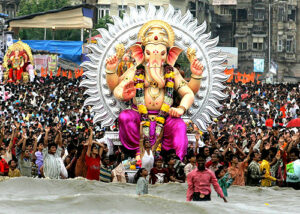
(Public Domain)
A lesson of love and devotion, the importance of wisdom and intellect, Ganesha constantly reinforces real-life lessons throughout the stories of his life. Ganesha is the epitome of Hindu Culture and constantly preaches the respect of all living beings – No matter how big or how small, everyone matters.




